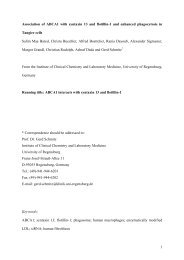SUNDAY, DECEMBER 4- Late Abstracts 1 - Molecular Biology of the ...
SUNDAY, DECEMBER 4- Late Abstracts 1 - Molecular Biology of the ...
SUNDAY, DECEMBER 4- Late Abstracts 1 - Molecular Biology of the ...
You also want an ePaper? Increase the reach of your titles
YUMPU automatically turns print PDFs into web optimized ePapers that Google loves.
<strong>SUNDAY</strong><br />
2058<br />
The F-BAR domain protein PACSIN2 associates to Rac1 and regulates cell spreading and<br />
migration.<br />
B-J. de Kreuk 1 , M. Ne<strong>the</strong> 1,2 , M. Fernandez-Borja 1 , E. Anthony 1 , P. Hensbergen 3 , A. Deelder 3 , M.<br />
Plomann 4 , P. Hordijk 1 ; 1 <strong>Molecular</strong> Cell <strong>Biology</strong>, Sanquin Research, University <strong>of</strong> Amsterdam,<br />
Amsterdam, Ne<strong>the</strong>rlands, 2 University <strong>of</strong> Virginia, Charlottesville, VA, 3 Leiden University Medical<br />
Center, Leiden, Ne<strong>the</strong>rlands,, 4 Institute for Biochemistry 2, University <strong>of</strong> Cologne, Germany<br />
The Rac1 GTPase controls cytoskeletal dynamics and is a key regulator <strong>of</strong> cell spreading and<br />
migration via signaling through effector proteins such as <strong>the</strong> PAK kinases and <strong>the</strong> Scar/WAVE<br />
proteins. We previously identified a series <strong>of</strong> regulatory proteins that associate with Rac1<br />
through its hypervariable C-terminal domain. These include <strong>the</strong> Rac1 activator β-Pix, which<br />
recruits Rac1 to focal adhesions, and <strong>the</strong> membrane adapter Caveolin1, which regulates <strong>the</strong><br />
poly-ubiquitylation and degradation <strong>of</strong> activated Rac1. Here, we show that Rac1 associates with<br />
<strong>the</strong> F-BAR domain protein PACSIN2, an inducer <strong>of</strong> membrane tubulation and a regulator <strong>of</strong><br />
endocytosis. We show that loss <strong>of</strong> PACSIN2 increases Rac1-GTP loading and promotes cell<br />
spreading and –migration. Conversely, expression <strong>of</strong> PACSIN2 reduces Rac1-GTP levels in a<br />
fashion which is dependent on <strong>the</strong> PACSIN2-Rac1 interaction, on <strong>the</strong> membrane-tubulating<br />
capacity <strong>of</strong> PACSIN2, and on Dynamin. In addition, we show that GEF-mediated Rac1-GTP<br />
loading is unaffected when PACSIN2 is expressed. These results demonstrate that PACSIN2 is<br />
an important regulator <strong>of</strong> <strong>the</strong> small GTPase Rac1 and that PACSIN2 limits Rac1-GTP signaling<br />
by promoting Rac1 inactivation.<br />
2059<br />
Control over acquisition <strong>of</strong> cell motility and cell migration by <strong>the</strong> RNA binding protein<br />
Dead end.<br />
M. Goudarzi 1 , T. U. Banisch 1 , E. Raz 1 ; 1 Cell <strong>Biology</strong>, ZMBE, Muenster, Germany<br />
Specification <strong>of</strong> zebrafish primordial germ cells (PGCs) depends on maternally inherited<br />
determinants. These factors, collectively termed <strong>the</strong> germ-plasm direct cells to enter <strong>the</strong><br />
germline fate and to acquire proper cell behavior. An important such maternally-provided germplasm<br />
component in zebrafish is encoded by <strong>the</strong> dead end (dnd) gene. The Dnd protein<br />
contains an RNA recognition motif and is specifically expressed in PGCs, where it is localized to<br />
<strong>the</strong> perinuclear granules. Knockdown <strong>of</strong> dead end results in severe defects in cell behavior (e.g.<br />
<strong>the</strong> acquisition <strong>of</strong> motility), cell fate maintenance and survival.<br />
We could previously show that Dnd functions by protecting specific mRNAs (e.g. tdrd7, nanos1<br />
and hub) from micro RNA–mediated translational inhibition and degradation in <strong>the</strong> germ cells, a<br />
process by which <strong>the</strong> same RNAs are repressed and degraded in somatic cells. To determine<br />
<strong>the</strong> molecular basis <strong>of</strong> <strong>the</strong> dramatic changes in PGC properties upon loss <strong>of</strong> Dnd, we identified<br />
RNAs regulated by miRNAs and <strong>the</strong> Dnd protein. The functional role <strong>the</strong> proteins encoded by<br />
<strong>the</strong>se mRNAs play in controlling cell shape and behavior will be discussed.<br />
2060<br />
Nonmuscle Myosin II Is<strong>of</strong>orms regulate microtubule dynamics in three-dimensional cell<br />
migration through <strong>the</strong> distinct MLC phosphorylations.<br />
S. Komatsu 1 , M. Ikebe 2 ; 1 Microbiology and Physiological Systems, UMass Medical School,<br />
Worcester, MA, 2 UMass Medical School, Worcester, MA<br />
Cell migration is an extremely complex process which is controlled by <strong>the</strong> rearrangement <strong>of</strong><br />
cytoskeletal systems. Most studies <strong>of</strong> cell migration have been focused on controlling <strong>the</strong><br />
actomyosin and microtubule networks, and studied a migrating cell on two-dimensional (2D)
















